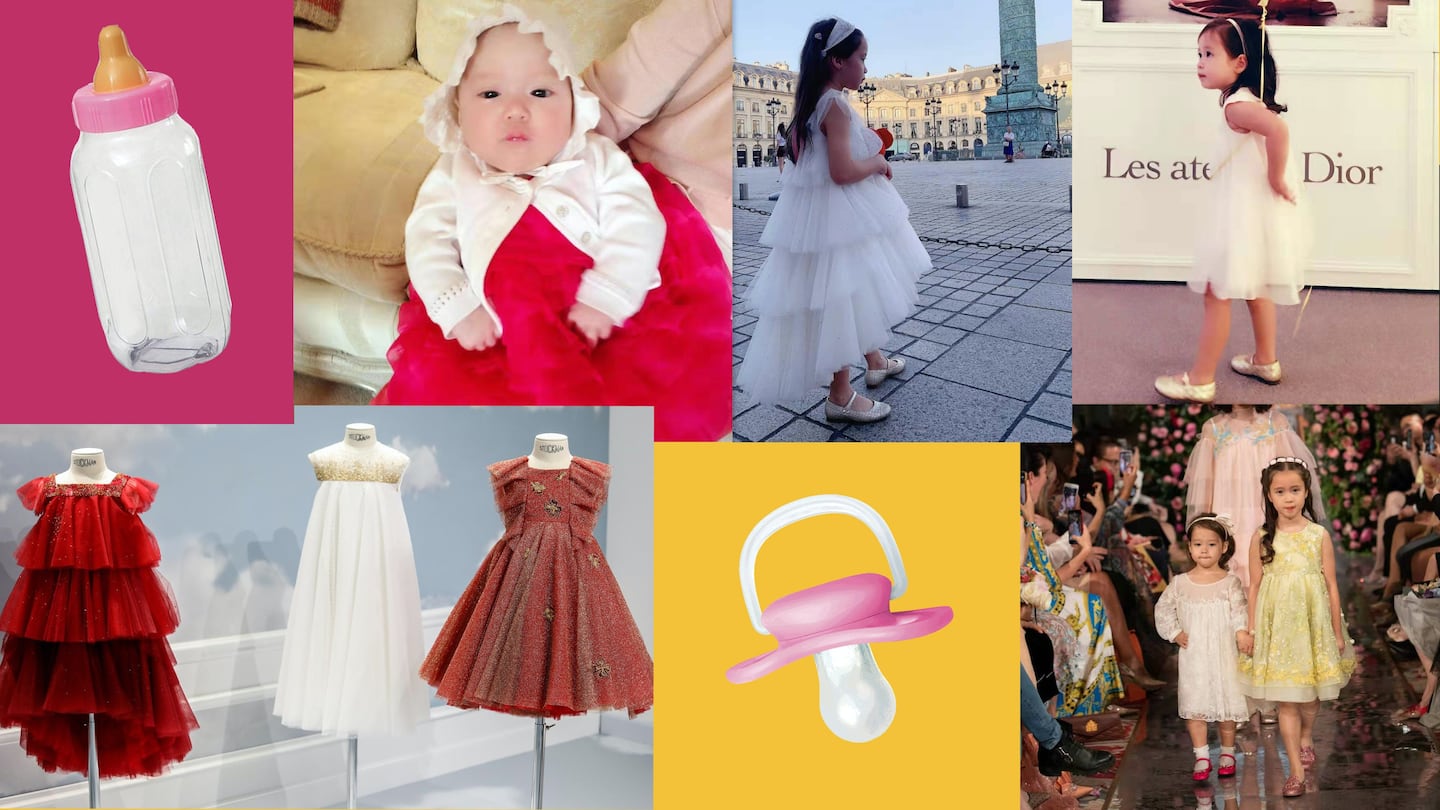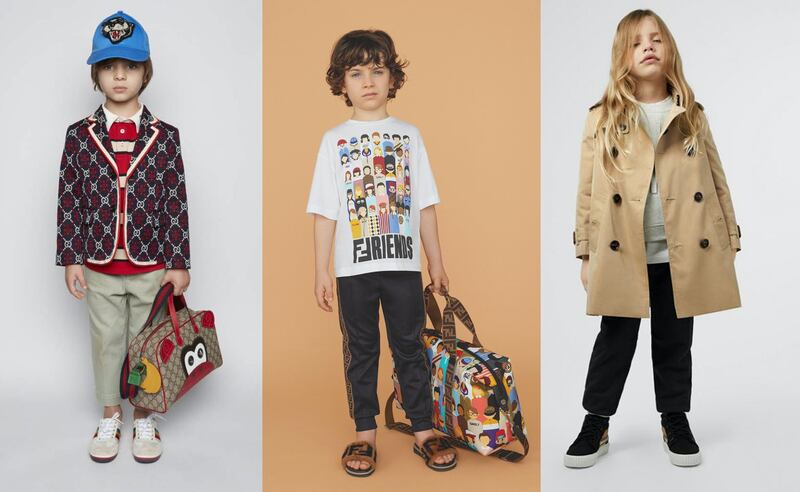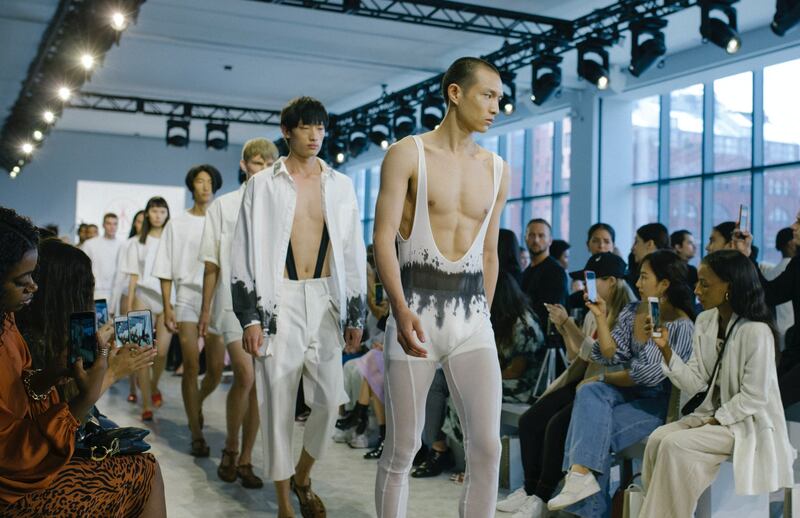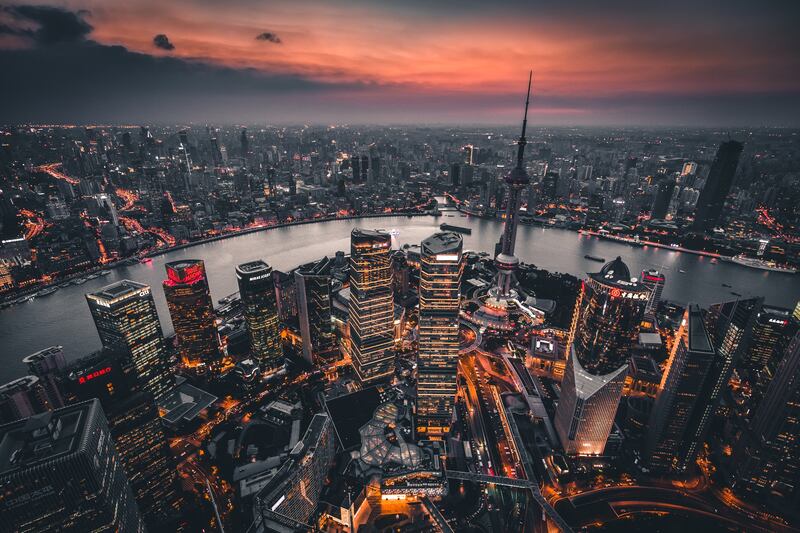
The Business of Fashion
Agenda-setting intelligence, analysis and advice for the global fashion community.

Agenda-setting intelligence, analysis and advice for the global fashion community.

SHANGHAI, China — At an appointment-only event for haute couture clients of Christian Dior in an elegant colonial-era Shanghai villa, the well-heeled ladies, celebrities and socialites in attendance come as no surprise.
What is a little more surprising are the Mary Jane-clad showgoers at the collection just next door to Maria Grazia Chiuri's latest offering — the diminutive customers of Baby Dior's couture collection.
With their client’s average age in the single digits and price tags for mini couture dresses topping $14,000, it seems astonishing that a market for luxury childrenswear at this level even exists. But on second thought, if there were just one market for this anywhere in the world, then China would be the place.
According to market research provider Euromonitor, the market for luxury childrenswear has grown steadily for the last five years, reaching sales of $6.6 billion in 2018, with the Asia-Pacific region alone worth more than $1.2 billion last year. Sales of childrenswear in China reached 209.1 billion yuan ($29.4 billion) in 2018, which means it only accounts for little more than 10 percent of the country’s overall apparel market. But the childrenswear sector’s double-digit year-on-year growth (a rate of 16.7 percent from 2017 to 2018) outperformed both womenswear and menswear.
ADVERTISEMENT
The childrenswear sector's double-digit year-on-year growth outperformed both womenswear and menswear.
“[China] is probably the most important market,” said Baby Dior Creative Director, Cordelia de Castellane, who first introduced the couture line six years ago. One-fifth of Baby Dior’s 25 worldwide stores are in China, with plans for undisclosed expansion in coming years.
“Chinese [customers] love the total looks; they are not scared about things. They love fashion and the kids, they go for it, they are not picky and I really love their looks,” De Castellane added, listing experience and limited editions as important factors for Baby Dior’s Chinese consumers, beating out price sensitivity in terms of purchasing very high-end childrenswear.
Selling the $29 Billion Dream
Chengdu-native Olivia Yin is a case in point. From almost the moment her oldest daughter Roselyn (known in the family as Rosie) was born, Yin dressed her in Baby Dior. Rosie, now age 6, wore her first couture Dior dress at the age of three months to celebrate her “100-days,” a milestone commonly marked with a party in China.
“All Rosie’s dresses until she was three or four were Baby Dior,” Yin said, adding that in the last few years she has had to incorporate more leggings into Rosie’s wardrobe to accommodate more active play, climbing and sliding, although for her and her daughters — Rosie also has a three-year-old sister, Sofia — couture doesn’t have to be occasion wear.
“I wear my Dior couture to go and do school pick up,” she laughed.

Rosie and Olivia matching in Dolce & Gabbana | Source: Courtesy
As a regular couture customer of brands such as Dior and Chanel herself, Yin sees the collection of couture children's pieces she has amassed for Rosie and Sofia as part of an elegant legacy she wants to pass on to her daughters.
ADVERTISEMENT
“I want Rosie to look back at all the photos of her childhood and see herself as beautiful, in all these beautiful dresses,” Yin explained.
She is not alone, as more Chinese millennial consumers become luxury consumers, and then become parents, they gravitate towards buying things for their children that suit their own taste. If, like Yin, their taste is for Dior Couture, that is what they will buy for their kids.
Adult Trends, Translated
China’s multi-brand behemoth, the Hong Kong-headquartered I.T started a children’s section as an experiment at a single store in Hong Kong two years ago. After seeing success there and experimenting with the concept in flagship stores in mainland China, the group is convinced of the potential for designer kidswear, planning further roll-outs (as well as perhaps a mono-store kids concept) in coming years.
“In Hong Kong, [parents] don’t have a lot of kids, maybe one or two kids, so we want to extend our fashion sense and style to the next generation,” I.T Vice President of Merchandising, Tracey Cheng, explained, “If I like Acne [Studios] a lot, I want to dress my kids in Acne as well.”
So far, the most popular brands among the childrenswear assortment include Acne Studios, Comme des Garçons Play and Balenciaga, with oversized tees for both adults and children proving popular.
In Hong Kong, parents don't have a lot of kids, so we want to extend our fashion sense and style to the next generation.
As in other parts of the world, there is a strong trend for matching parent-child looks in China, driven by social media, certainly, but also in Asia driven by a tradition of “love dressing” where couples or whole families wear matching outfits to show their affection and togetherness. Today’s version in China is part of this tradition, with a decidedly upmarket bend.
According to RTG Consulting’s Angelito Tan, China’s traditional gifting culture is also a driving factor.
ADVERTISEMENT
“Even if parents [are] pragmatic about buying luxury clothing for their own children that may be outgrown in a year’s time, we have seen less hesitation when gifting luxury clothing to commemorate milestones in children’s lives of friends or extended family,” he said, adding that messaging from luxury childrenswear brands that focuses on gifting has found success in the market.
Tan also sees the broader streetwear trend as an opportunity for kidswear, helped by the fact that the price point is more accessible to a larger percentage of the population, and the nature of streetwear, which is comfortable and well-suited to child’s play.
“The explosion [of] luxury premium sneakers is a good illustration of how brands can go beyond their current offering to craft icons in the children’s luxury footwear scene which is currently untapped,” he said.
No Baby Boom, No Problem
Childrenswear brands rushed into the country in 2016, perhaps banking on a baby boom on the heels of the implementation of China's two-child policy in January of that year, after decades of limiting most couples to having only one child. Burberry Children, Gucci Children and Fendi Kids became more common and more prominent in tier one city shopping malls and via marketing campaigns on occasions such as Children's Day (which falls on June 1 and is widely celebrated in China).
However, somewhat counter-intuitively, what seems to be driving growth for luxury designer apparel in China is not that Chinese families are now allowed to have more kids, but the fact that they are actually having less.

Childrenswear from Gucci, Fendi and Burberry | Source: Respective brands
Even with the official implementation of the two-child policy and a middle-class consumer band almost 400 million strong, an expected baby boom has not really materialised (although the 17.9 million babies born in China in 2016 was a 21st century record, the number of births declined by 3.5 percent to 17.2 million in 2017, and declined again to 15.2 million last year, according to official figures).
The decision to have only one child, even as they move up the consumption value chain, appears to make Chinese families more likely to spend more money on that child across the board, for everything from education and health, to fashion.
“Now, because of the [legacy of the] one child policy in China and also in Hong Kong we don’t have a lot of kids, so people are really willing to invest a lot more money in childrenswear,” Cheng said.
Yin agrees there is little hesitance among many Chinese parents of her generation in splurging on their children, even more so than they would on themselves.
“Anything that is [thought to be] good for the children, they will do it,” she said. “They will spend all their time and money for them.”
时尚与美容
FASHION & BEAUTY

The finale at Threegun’s SS20 show | Source: Alibaba
At NYFW, Tmall Balances Commerce with Creativity
This week, Alibaba-owned e-commerce platform Tmall presented its third "China Cool"-themed showcase of Chinese designers at New York Fashion Week. The five featured brands ranged from the up-and-coming to larger commercial names: emerging labels i-am-chen and Songta showed alongside intimates brand Threegun, fashion giant Peacebird and contemporary brand Rizhuo. For Tmall, the move hopes to boost the credibility of homegrown talents to a global audience, though equally significant is the recognition that showing at NYFW will bestow on the designers back home. While the mix of emerging talent and commercialised brands may have felt disjointed (previous years' shows linked designers through commonalities such as their streetwear aesthetics), this intersection of commerce and creativity continues to drive Tmall's success. (Jing Daily)
Louis Vuitton to Expand Production to Meet Strong Demand in China
In a bid to keep up with consumers in the mainland, LVMH Group's top revenue-driving brand will hire another 1,500 French handbag makers by 2022. At present, LV employs around 4,300 manufacturing staff across its 16 leather goods workshops at home, and new hires would mean the launch of two new factories to house them. In spite of US-China trade war tensions, demand for the brand's pieces from China accelerated in the second quarter from the first three months of the year, and arch-rival Kering is seeing a similar boost in the mainland. However, the company has no plans on moving any manufacturing closer to the region and will continue to focus on hiring and training manufacturing staff in France and the US, tying into luxury's wider talent problem. According to a new report, the sector is in the throes of a talent shortage, as recruiting and cultivating employees becomes trickier thanks to China's ageing population, tech advancement and a lack of collaboration between employers and universities. (Reuters)
Li Ning Appoints Joint CEO, Ignites Retirement Rumours
Last week, the sportswear giant appointed Uniqlo's Chief Executive of South Korean operations Kosaka Takeshi as its joint chief executive, prompting questions of whether its eponymous founder, chairman and retired Olympic gymnast will be retiring for good. Li has been adamant that he won't be helming it for the long run, suggesting that the joint CEO move will precede his abdication. The Beijing-based company recently marked its return to profitable growth and its shares have more than quadrupled in the past two years — in response to Kosaka's appointment, the company's shares rose by as much as 5 percent in Hong Kong on September 2. (Retail Observer)
科技与创新
TECH & INNOVATION

Source: Franck V.
Alibaba-Backed AI Start-up Sees over $7.5 Billion Valuation
On the back of massive investments from the likes of Softbank, five-year-old Hong Kong-based Sensetime — now the world's most valuable AI start-up — has seen its valuation hit the $7.5 billion mark. The firm was reportedly valued at $4.5 billion just last year following a $600 million funding round led by Alibaba and $620 from investors including Fidelity International. Though the start-up's revenue is growing at triple digit percentages, its Chief Executive Xu Li has said that he has no plans for an IPO, and the firm's cash flow remains negative due to investments in new areas. (Tech in Asia)
TikTok Shifts Focus to US, India and Japan
As its growth slows at home and competitors Kuaishou and YY gain ground in the mainland, the Bytedance-owned viral video app (known locally as Douyin) is prioritising its faster-growing markets. Interestingly, the tech firm — which recently experienced a leadership shake-up — has removed the UK from its list of countries previously termed strategically important, with the top three countries receiving their own general managers. It's no surprise that India has made the list; since the start of the year, TikTok has grown its daily active users in the country by 50 million, accounting for half of TikTok's total global DAU according to a LatePost report. (Technode)
China’s Internet Industry Is Causing ‘Significant’ Carbon Emissions
According to a new study by Greenpeace East Asia and the North China Electric Power University, the Chinese internet industry's reliance on coal power resulted in an estimated 99 million metric tons of carbon dioxide emissions last year. The mainland's internet data centre industry is currently 73 percent powered by coal (renewable energy accounted for just 23 percent last year), and the sector's power consumption is likely to grow exponentially over the next five years. Chinese government bodies are also promoting stronger industry supervision and creating greener data centres — Shanghai has regulations in place to limit power usage for newly built facilities, and Beijing prohibited the construction of new facilities other than cloud computing data centres — but researchers reckon that optimising energy efficiency won't be a panacea. The sector needs to address the carbon emissions and pollutants that are the root of the problem. (Sixthtone)
消费与零售
CONSUMER & RETAIL

Shanghai | Source: Denys Nevozhai
As China Overtakes the US as the Biggest Retail Market in the World, Which Cities Will Thrive?
In its newest report, Savills analysed 50 leading retailers' expansion rates over the last 12 months, looking at which cities are likely to see future retail expansion given the country's ongoing economic and demographic shifts. While Shanghai, Beijing, Shenzhen, Chengdu and Hangzhou are still the highest-ranking retail hotspots, the gap in retail presence between top-ranking cities and the others on the list has narrowed in the last three years. Additionally, established brands are slowing down their expansion efforts as emerging brands accelerate, and local fashion and digital brands are leading expansion overseas, with a focus on Southeast Asia. Despite US-China trade tensions, the demand for quality retail brands hasn't faltered, and effectively engaging with China's growing middle class and millennial population will give brands the winning edge. (Savills)
Two Become One With Alibaba’s $2 Billion Kaola Acquisition
After weeks of "will they, won't they," the Chinese retail giant announced its acquisition of NetEase's cross-border e-commerce unit Kaola, which will continue to operate under its current brand as a separate entity to Alibaba's own platform. The move has merged the top two platforms in the field, forming a cross-border superpower — according to data from Analysys, the two platforms' joint market shares equal more than half of China's cross-border e-commerce market, valued at a staggering $90.83 billion yuan (around $12.70 billion) in the first quarter. Understandably, the news is worrying for other players in the field: JD.com, VIP.com and Suning Global, to name a few. In related news, Alibaba Group founder Jack Ma stepped down as the company's chairman on September 10. (Technode, BoF China)
TikTok’s Chinese Competitor’s Shopping Festival Breaks Records
Tencent-backed livestream-focused platform Kuaishou announced that it generated over 100 million yuan (around $14 million) in sales during its three-day "Reliable Goods" online shopping festival that took place at the end of August. Kuaishou is up against serious competition, be it from China's top video app Douyin, or where shopping festivals are concerned, against JD.com and Alibaba — JD.com's event this year brought in $29.2 billion, whereas according to Alibaba, its 6.18 festival helped over 110 brands to generate over 100 million yuan ($14.5 million) in gross merchandise volume. Unlike Douyin, Kuaishou hasn't made a dent in the global market, but the app is unique in its popularity amongst netizens in China's lower-tier cities. The fact that the festival's proclaimed higher-quality "reliable goods" brought higher conversion rates illustrates growing disposable incomes in China's lower-middle-income demographic — a pattern that will likely work to the firm's advantage. (Ebrun)
政治、经济、社会
POLITICS, ECONOMY, SOCIETY

A cotton field | Source: Trisha Downing
Xinjiang’s Forced Labour Problem A Growing Risks for Global Brands
The expanding use of alleged forced labour in Uighur detention camps in the Chinese autonomous region of Xinjiang will threaten supply chains of brands sourcing of China, according to the latest research from Verisk Maplecroft. Authors say that exporting raw materials from the region will link brands to issues such as forced and child labour (with cotton being the highest risk item), while Xinjiang's significance for Beijing's One Belt One Road initiative will complicate matters further. And as analysts expect the Chinese government to mask the traceability of goods and components, links to forced labour are unlikely to be prevented by standard due diligence practices. Where Beijing continues to claim that the labour engaged at these facilities is vocational training meant to help students integrate into Chinese society, the abuses faced by some locals are unlikely to persuade the international community otherwise. (Verisk Maplecroft)
Tibet: China’s Next Hotspot for Luxury Growth?
A growing number of Tibetans are being educated in the West and developing tastes for high-end fashion, and China's top retail players are taking note. On September 3, Chengdu-based developer Chengdu IFS and its affiliate Wharf Holdings held a "Himalayan Style" themed event in the Tibetan capital Lhasa, bringing global brands and retailers Chopard, MaxMara, Lane Crawford and Ports 1961 to the region for the first time. The move is a considered one for Chengdu IFS: more than 20,000 Tibetans live in Chengdu (in the neighbouring province of Sichuan), while millions of Tibetans visit the city annually. According to the China Business Research Institute, Tibetan retail consumption has grown significantly in recent years — it was dubbed the fastest growing Chinese province for retail consumption in 2017 (albeit from a low base), and ranked fourth in Alipay spending the same year. With Chengdu IFS and Wharf Holdings having pegged Tibet as a major driver for future growth in China, it is likely that other retail giants will follow. (Christina Yao for BoF China)
Hong Kong Tourism Suffers Worst Downturn Since 2003 Virus Outbreak
As a result of the pro-democracy protests that have taken over Hong Kong's streets for the past 14 weeks, the city's tourism has seen its worst downturn in more than a decade. According to its financial secretary, Hong Kong's tourist arrivals are down 40 percent year-on-year this month, the worst decline since 2003 when it succumbed to a severe acute respiratory syndrome (Sars) outbreak. Tourism is one of Hong Kong's four pillar industries and businesses from luxury retailers to hotels, eateries and Disneyland are feeling the repercussions, with hotel room rates estimated to be down by 40 percent. Though the controversial extradition bill that triggered protests in late March has since been withdrawn by Chief Executive Carrie Lam, the move hasn't satisfied protestors who are demanding greater democracy and an inquiry into alleged police brutality during past demonstrations, and the unrest shows no sign of dissipating. (SCMP)
China Decoded wants to hear from you. Send tips, suggestions, complaints and compliments to our Shanghai-based Asia Correspondent casey.hall@businessoffashion.com.
With consumers tightening their belts in China, the battle between global fast fashion brands and local high street giants has intensified.
Investors are bracing for a steep slowdown in luxury sales when luxury companies report their first quarter results, reflecting lacklustre Chinese demand.
The French beauty giant’s two latest deals are part of a wider M&A push by global players to capture a larger slice of the China market, targeting buzzy high-end brands that offer products with distinctive Chinese elements.
Post-Covid spend by US tourists in Europe has surged past 2019 levels. Chinese travellers, by contrast, have largely favoured domestic and regional destinations like Hong Kong, Singapore and Japan.